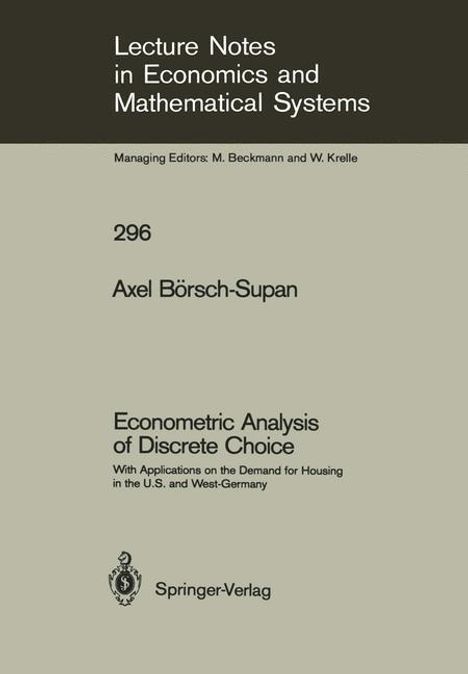Axel Börsch-Supan: Econometric Analysis of Discrete Choice, Kartoniert / Broschiert
Econometric Analysis of Discrete Choice
- With Applications on the Demand for Housing in the U.S. and West-Germany
(soweit verfügbar beim Lieferanten)
- Verlag:
- Springer, 11/1987
- Einband:
- Kartoniert / Broschiert, Paperback
- Sprache:
- Englisch
- ISBN-13:
- 9783540185345
- Artikelnummer:
- 2992078
- Umfang:
- 228 Seiten
- Copyright-Jahr:
- 1987
- Gewicht:
- 369 g
- Maße:
- 241 x 166 mm
- Stärke:
- 15 mm
- Erscheinungstermin:
- 4.11.1987
- Hinweis
-
Achtung: Artikel ist nicht in deutscher Sprache!
Klappentext
This book is a treatise on empirical microeconomics: it describes the econometric theory of qualitative choice models and the empirical practice of modeling consumer demand for a heterogeneous commodity, housing. Accordingly, the book has two parts. The first part gives a self-contained survey of discrete choice models with emphasis on nested and related multinomial logit models. The second part concentrates on three sUbstantive questions about housing demand and how they can be answered using discrete choice models. Why combine these two distinct parts in one book? It is the interaction between theory and application in empirical microeconomics on which we focus in this book. Hence, emphasis in the methodological part is on practicability, and emphasis in the applied part is on the usage of the proper econometric specifications. Econometrics means measuring economic phenomena. Because nature (ironically, in the case of economics, this is most often the government) rarely provides us with well-defined economic experiments, measurement of economic phenomena usually requires an elaborate statistical apparatus that is able to separate concurrent and confounding phenomena. Discrete choice models have proved to be a very convenient apparatus to study the complex issues in housing demand. We present models, techniques, and statistical problems of discrete choice in the first and methodological part of the book, written in conventional textbook style.



